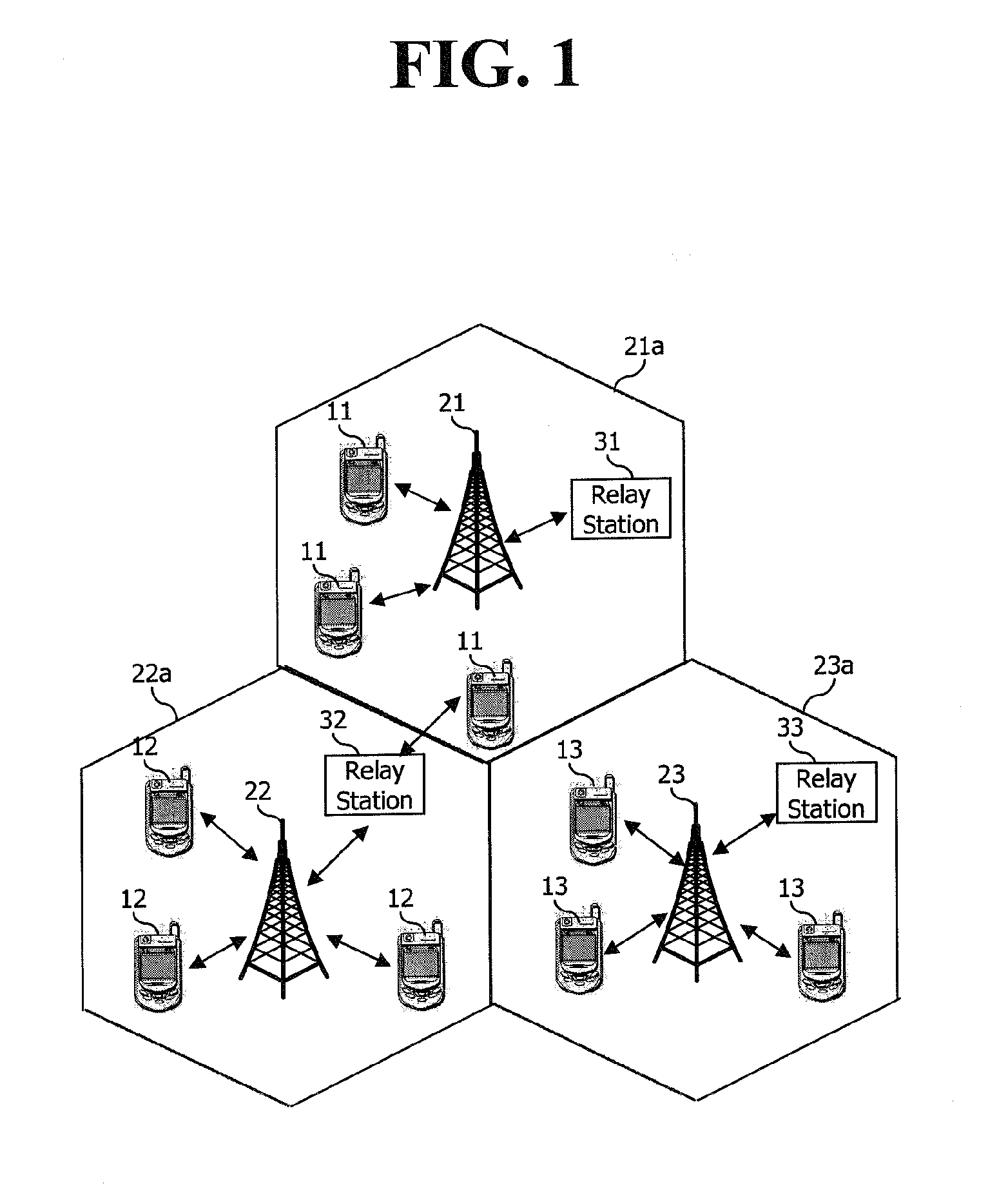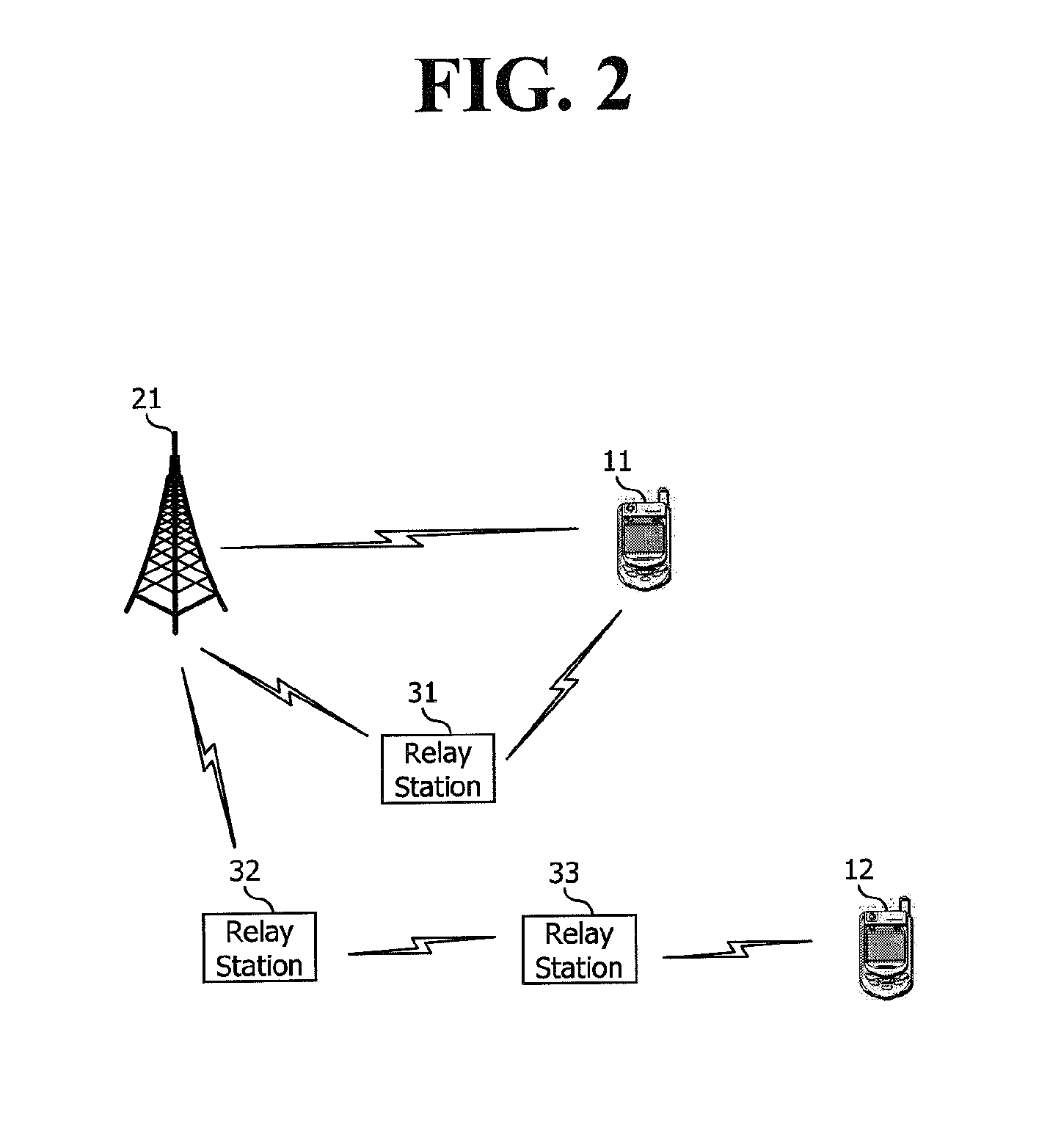Method for avoiding interference
a technology of interference prevention and interference prevention, applied in the field of radio communication, can solve the problems of inability to perform a communication with the bs, inability to perform a communication with the ms, and inability to perform a communication with an inferior communication quality, so as to reduce the influence of interference, reduce interference, and reduce interferen
- Summary
- Abstract
- Description
- Claims
- Application Information
AI Technical Summary
Benefits of technology
Problems solved by technology
Method used
Image
Examples
first embodiment
[0063]FIG. 5 is an exemplary view illustrating the present invention.
[0064]As can be seen from FIG. 5, a first base station 210 and a second base station 220 are adjacent to each other. A first relay station 310 is positioned at an outer periphery of the coverage of the first base station 210. And, a first terminal 110 is placed within the coverage of the first base station 210, and a second terminal 120 is placed within the coverage of the second base station 220. The first base station 210 and the second base station 220 are controlled by a control station 500 (e.g., RNC or SGSN of UTRAN, or MME (Mobility Management Entity) or Serving-GW of EPC (Evolved Packet Core), or IEEE 802.16dml ASN-GW or CSN).
[0065]An entity in the first base station 210 schedules UL radio resources and DL radio resources. Alternatively, the control station 500 schedules UL radio resources and DL radio resources of the first base station 210.
[0066]The first base station 210 transmits, to the first relay sta...
second embodiment
[0072]FIG. 6 is an exemplary view of the present invention.
[0073]As can be seen from FIG. 6, a first base station 210 and a second base station 220 are adjacent to each other. A first relay station 310 is positioned at an outer periphery of the coverage of the first base station 210. And, a first terminal 110 is placed within the coverage of the first base station 210, and a second terminal 120 is placed within the coverage of the second base station 220.
[0074]The first base station 210 schedules UL radio resources and DL radio resources.
[0075]A method for scheduling radio resources of the first relay station 310 includes a center-concentrated scheduling method and a distribution-type scheduling method. According to the center-concentrated scheduling method, the first base station 210 directly allocates radio resources of the first relay station. On the other hand, according to the distribution-type scheduling method, the first base station 210 schedules radio resources to the first...
fourth embodiment
[0101]FIG. 9 is an exemplary view of the present invention.
[0102]Referring to FIG. 9, in a similar manner to FIG. 8, the first relay station 310 may transmit backhaul data to the first base station 210 in some cases (e.g., when UL resources are deficient). Data transmission by the relay station with using DL resources may be referred to as DL band stealing or DL subframe stealing.
[0103]In this case, a transmission signal of the first relay station 310 may cause interference with DL transmission to the second terminal 120 by the adjacent second base station 220.
[0104]In order to solve the interference, in the fourth embodiment, the second base station 220 identifies the DL resources through which the backhaul data is transmitted, in a similar manner to the third embodiment. And, the second base station 220 schedules its DL resources, based on the identified DL resources. For instance, the second base station 220 may not allocate its radio resources corresponding to a time point when ...
PUM
 Login to View More
Login to View More Abstract
Description
Claims
Application Information
 Login to View More
Login to View More - R&D
- Intellectual Property
- Life Sciences
- Materials
- Tech Scout
- Unparalleled Data Quality
- Higher Quality Content
- 60% Fewer Hallucinations
Browse by: Latest US Patents, China's latest patents, Technical Efficacy Thesaurus, Application Domain, Technology Topic, Popular Technical Reports.
© 2025 PatSnap. All rights reserved.Legal|Privacy policy|Modern Slavery Act Transparency Statement|Sitemap|About US| Contact US: help@patsnap.com



